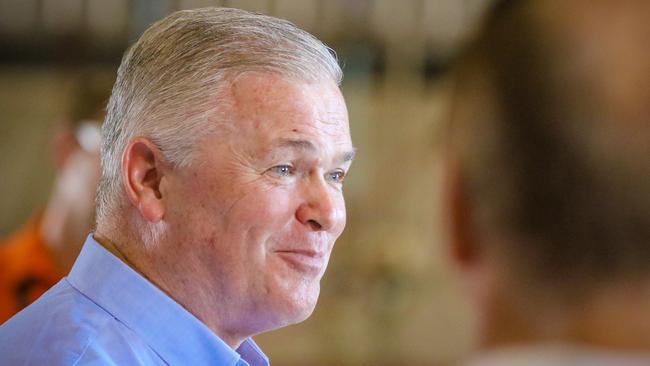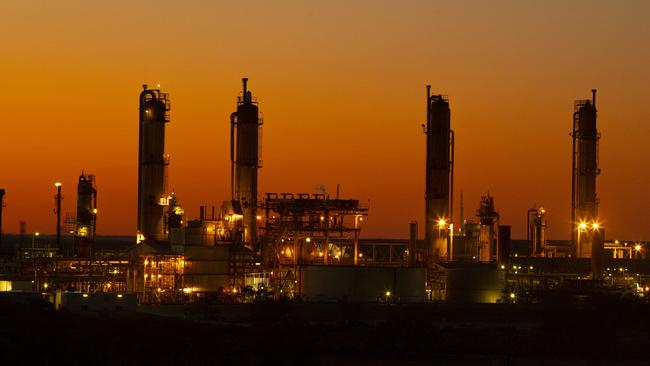Santos executive warns companies ‘will die’ if they don’t switch to new energy sources like hydrogen
Australian gas giant boss says companies have no choice but to transition to new energy sources, such as hydrogen, if they’re to survive.

The head of one of Australia’s biggest fossil fuel companies has warned that companies will have to transition to new energy sources “or die”.
Kevin Gallagher, the managing director of Australian gas giant Santos, said he knew of no other company in the oil and gas sector around the world that had a more aggressive transition strategy.
He told The Australian on the sidelines of COP26 on Glasgow that industries were transitioning all the time, likening the current energy and fuel industry situation to the coal mining industry in Britain and the woollen mill industry in central Scotland.
Mr Gallagher said Santos had a “very progressive strategy”, noting that while governments needed to create policy to incentivise and not block industry, it was companies themselves that would make the transition to different energy sources.
“It will not be any government that transitions, it will be industries that will transition. And companies that want to resist that, or companies that cannot do it, they will die. They will die.’’
“The energy and the fuels industries are now facing the first transition in 100 years. But it has happened before.’’
Santos announced earlier in the week that $A220m carbon capture storage development would go ahead in Moomba, located around 770km north of Adelaide, after Canberra agreed it could receive carbon credit revenues from the emissions reduction fund.
“We‘ve told our investors that based on our own forecasts, and what we think carbon prices will do through 2030 and beyond. We would see this is being a positive return project,’’ Mr Gallagher said.
When asked why Santos had not reduced emissions at Moomba before now, he said decarbonising was a very costly process.
“The ability to generate carbon credits gives an incentive to anybody to put carbon back in the ground,’’ he said.
Mr Gallagher said Santos was also looking to build green hydrogen plants, despite his belief that green hydrogen would not be economically viable for a decade.
He said blue hydrogen – which is produced by using natural gas in combination with carbon capture storage – had a very low emissions profile.
“We believe we can get it (blue hydrogen) to market quicker, and we have an abundance of natural gas in Australia which becomes a competitive advantage,’’ Mr Gallagher said, while expressing scepticism that it would be possible to make all of the hydrogen needed by 2050 by using renewables.

Mr Gallagher said while Australian miner and green hydrogen advocate Andrew Forrest had “nothing but criticism” for companies like Santos, he acknowledged Mr Forrest was creating a lot of publicity about what needed to happen.
“The oil and gas industry has been injecting gas back into reservoirs for more than 50 years, successfully – sometimes for enhanced recovery, sometimes for storage – so this is nothing new for the industry. For oil and gas to decarbonise and to use carbon capture storage as a means to do that is a very proven technology.”
Santos’ Moomba project could potentially store 20 million tonnes of carbon per annum for 50 years.
“What that will do for us is to now go and invest and electrify some of our operations where we currently consume and burn gas,’’ he told The Australian.
“We can bring that gas now back to Moomba to generate electricity and run out those wires and use solar and renewable energy to run those facilities.
“That allows us to sell more gas, so instead of burning it for fuel we are able to put it to the market for customers who require it, but very importantly capture the carbon emissions from that back at Moomba.
“So electrification is the next stage, but it’s only this initial investment that allows those projects to be viable.”
Mr Gallagher foreshadowed that once Santos began producing hydrogen and ammonia, it would turn its attention other projects, such as sustainable jet fuel.
“By getting the hydrogen economy going, there‘ll be a lot of spin off opportunities,” he said.






To join the conversation, please log in. Don't have an account? Register
Join the conversation, you are commenting as Logout